Rapid Transport
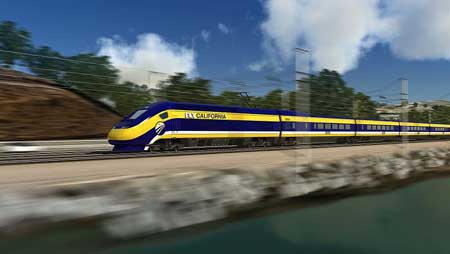
(California High Speed Rail. Imaginary photo by California High-Speed Rail and Unicorn Authority.)
Sorry I am late this morning. I have been trading polemics with the usual suspects and Rhonda at the front desk called to ask if I had a woman in the unit, since there was a car parked with a guest pass under the tree that Management wants to cut down, and the sponsoring unit number was written as “901” and the building only has eight floors. She thought it might have been transposed.
I looked around the unit and could not find any stray females, and responded that I was not responsible. There are enough tree guys out there that they could probably just pick up the car and move it themselves if they felt like it. I am watching with interest, either on the off chance that a woman will appear, breathless, or the guys will just get to work on the trees and bounce things off the roof.
Being a man of leisure these days, I have had more time to trade email with under-employed buddies (there are a lot of us these days, as the Great Recession and the budget chaos snags the War Industry) and that means more time for more messages to fly around.
I am not going to start a rant this morning- I am ranted out, anyway, and I don’t know what to think about anything, except advance the proposition that if the Government doesn’t have to follow its own laws, why on earth should we? Just saying…
I don’t know if you have been following the saga of High Speed Rail out in California- part of that “shovel ready” thing that allowed the government to “invest” billions of stimulus cash in unicorns and the UAW and electric cars that have cruising ranges of like 36 miles.
There was nothing that wasn’t half-baked enough to get funded. The High Speed Rail thing was a corker. It was sold to the taxpayers with a loss-leader price- the PR effort in 2008 claimed the project could be done for about $33 Billion, while the current estimate for what it will really cost has ballooned to something over $90 Billion, and estimates for ridership in the dim and distant future (2030, or about my personal self-life) are about a third of what boosters claimed it was going to be.
In the meantime, there are problems with condemning private property along the proposed rights-of–way, the proposed speed and safety goals are unachievable by any current technology, it won’t be able to go nearly aas fast as advertised due to the fact that the rail network will still rely on freight tracks unless a lot more money is spent, and the reduction in CO2 emissions will be inconsequential.
Other than that, things are going great for the project, except for the fact that a Sacramento County judge ruled last Friday that the California High-Speed Rail Authority failed to comply with the financial and environmental promises it made to get the project approved by 52.5% of the voters, and “abused its discretion by approving a funding plan that did not comply with the requirements of the law” by failing to identify “sources of funds that were more than merely theoretically possible.”
That was the problem with the wind farms and the electric cars and the solar panels and all the rest of the industries that were ballyhooed as the solution to a problem that arguably does not exist- fossil fuel scarcity- the use of which is to be prohibited because of a much over-hyped crisis that may be cooling all by itself.
Don’t ask me. Surface temperatures have not increased in over sixteen years even though the PPM of CO2 has continued to increase, the number of tornedos and tropical storms has declined, and the smart money is starting to worry about how cold it is going to get as the Sun goes quiescent.
But I am not going to go down that road this morning. Reasonable people can differ on the matter, though I have not seen many of them around lately. I was talking to Argo about it the other day, and he expressed an honest belief based on what has been said and taught by the alarmists over the last couple decades. He thinks it is only prudent to be cautious since the stakes are so high.
“You have a point,” I said, “but by that standard we have to start building really powerful radars to look for comets just in case one hits us. The stakes are really high. Think of the dinosaurs.”

(A sketch of the Hyperloop capsule approaching Hollywood and Vine with passengers onboard. AP Photo/Tesla Motors.)
That was when I started to think about alternatives to reality as it is, just like the wild man Elon Musk, the technology entrepreneur who is going to commercialize space travel. Maybe it is the trouble with the high-speed rail program, I don’t know, but he has a plan to leap-frog the train. He has the coolest proposal I have seen: a transport system he says would make the nearly 400-mile trip between San Francisco and LA in half the time it takes an airplane. His “Hyperloop” system would use a large tube with capsules inside that would float on air, traveling at over 700 miles per hour.
To deal with the right-of-way issue, he plans to run it down the middle of I-5, and pull it off for a tenth the cost of high-speed rail.
Forgive me if I am skeptical of the whole thing. I think we have bought quite enough unicorns for this crisis, and even if he could pull it off, the idea of some terrorist putting a Rocket Propelled Grenade into the side of the tube just when I happen to be passing by is quite more than I could bear- at least at 700 MPH. A learned colleague claims it is all Bullshit, at least as far as the initial cost estimates go, but you never know.
With the right government funding, maybe it can work as well as the Volt.
Anyway, that got me to thinking about fantasies that were actually real. Back in the days when satellite imagery was a pretty big deal there was a target we identified on the Caspian Sea in the former USSR. It appeared to be a giant flying boat of some sort. The smart guys back in Washington determined that it was probably a wing-in-ground (WIG) effect airplane that was intended to fly fast and low over the surface of the ocean and deliver troops and material in large quantities mucho pronto.
We called it “The Caspian Sea Monster.”

(The Monster underway. Photo MoD.)
It was a wonder to the world outside our own- a sort of Howard Hughes Spruce Goose of technology (though the two have much in common) and the speculation was that a fleet of these could very well provide the high-speed capability Governor Moonbeam desires and no tracks or land-based insfrastructure to deal with- just the terminals and the platform itself.
The Soviets called the monster the “KM.” It was designed in the mid-sixties and was unique in terms of size and payload. It had a wingspan of 37.6 m, a length of 92 m, and a maximum take-off weight of 544 tons with all ten Dobrynin VD-7 Turbojets thundering. Cruising speed may not be as much as Mr. Musk’s 700mph Hyperloop, but could provide at least something faster than the high-speed train, no right of way required, and the entire West Coast open to service.
The Monster never actually got into service, but it struck me that if I contacted one of my pals who has pals in the MoD in Moscow, I might be able to pick up the plans and maybe the remaining hull.
If I made the right donations to the right party, and got the ear of Governor Moonbeam, I might be able to whisper that this is an idea whose time has come again.
It is a proven technology, I thought. We can do this, and serve all the people of California. I could do this for a billion or so. What could go wrong? Even if I had to give a chunk of it to the right politicians, I would still be way ahead.
Do you think I could borrow your cell phone and make some calls?

Copyright 2013 Vic Socotra
www.vicsocotra.com
Twitter: @jayare303
Into the Wild
Well, Gentle Readers, I had hoped to address you this morning with a tale of triumph, and the announcement that the Disctrict Stones Project was closed out, just as my physical abilities to do so are drifting away.
Sorry- just like everything else these days, I failed. I can tell you that I have a new sense of just what Major Andrew Ellicott and Benjamin Banneker confronted when the set out to clear a twenty-foot wide path around the boundary of the Federal District of Columbia, and place the forty marker stones at one mile intervals to designate the border of the capital of the new republic.
I am here to tell you that was a task I did not appreciate until I found myself in their world, away from the comforts of today.
The physical world is definitely not boring. In fact, for a gimp entering geezerhood, it can be downright terrifying.
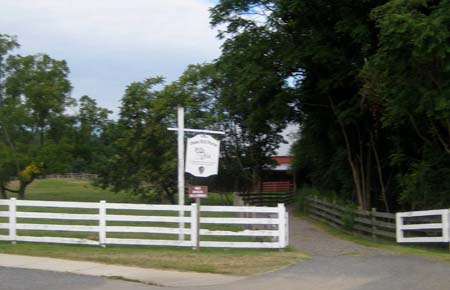
(Oxon Hill Farm. operated by the National Park Service).
I will stay away from politics this morning. It is making me more than a little nuts, this administration that so typifies the four “I’s”: inexperienced, inept, incompetent and illegal. History is going to have to sort that out- in fact, we will take a look at the alleged high-speed rail in California and a Russian alternative tomorrow.
But it was quite a shock to the system to find that what appeared to be a simple excursion of mild historical interest actually meant putting myself at risk in the wild, while still in the midst of the city.
I really wanted to close out the saga of the District Stones- in a moment of wild optimism, I even mused about hitting NE 5, the one in the deep woods near the intersection of Eastern and Kenilworth Aves, which is in a dicey neighborhood with no decent place to leave the car with any certainty it would be there on return. These things really require a expeditionary party, based purely on issues of personal safety. That is part of the attraction to the quest, since it is nothing that the average tourist would ever have the energy or insight to accomplish.

(This is the goal. We did not get there. The green cage was placed around the stone by the DAR in 1917 to protect them, and is the best “signature” to find the Stones, since some are truncated by wear or mischance almost to the level of the soil).
The description in the guide of how to reach SE 9, the last stop before the boundary jumps west across the Potomac, was quite vanilla:
“You can reach this stone on foot by following the partially-paved path that leads to Oxon Hill Farm from either D.C. Village Lane in Washington or the intersection of Oxon Run Drive and Audrey Lane in Maryland. Leave the path when it turns away from Oxon Cove; then follow the Oxon Cove shoreline to the base of Oxon Cove Bridge, where you must cross underneath I-295 to get to the Potomac River. From the endpoint of the large rocks that surround the base of the bridge, follow the Potomac shoreline about 1,000 feet southwest until you are just past due west of the Masonic Memorial (across the river) and the bridge is no longer visible behind you. If you are on a small sandy beach with car tires and debris, you are in the right place. The stone is 120 feet to the east in the forest at the foot of a hill. From the shoreline, it is just possible to make out the fence protecting the stone, although less so in spring and summer.”
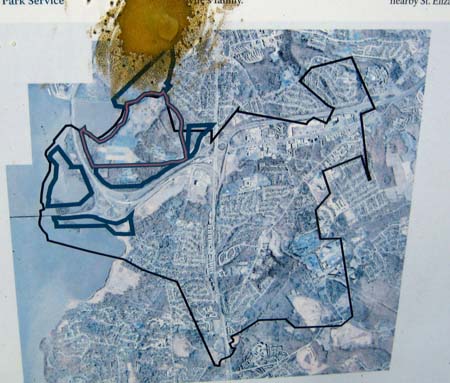
(Aerial photo of Oxon Hill Farm with the cover and interstate I-295 to the upper right).
My pal Argo agreed to meet up at the Oxon Hill Farm parking lot. It seemed safe, and a place we could leave a couple Yuppiemobiles without risk of having them stolen or trashed in what I thought would be a brief excursion.
We started off incorrectly- we walked into the historic farm area, operated by the National Park Service. My leg was throbbing after just a couple hundred feet. And I can tell you whoever wrote the above directions should be dragged out and beaten severely, then shot.
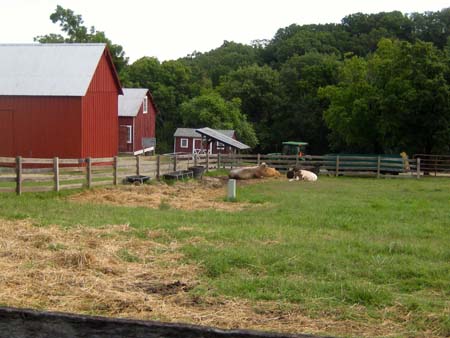
(Oxon Hill Farm is bucolic and delightful. It is also the wrong way to the Stone. The Park Service has a program to “Meet the Cows.” We did not participate.)
There is indeed a paved road down the bluff toward river level. It actually was quite pleasant once the grade eased- I can’t walk downslope as well as I would like, and the arthritis in the “good” leg has proceeded apace since the “bad” leg has been damaged, restricting my ability to walk normally.
Anyway, we saw a couple deer in a neatly mowed pasture and chattered away as we went, confident we would see the stone and be done with the outing shortly. Remember that part above about “Leave the path when it turns away from Oxon Cove; then follow the Oxon Cove shoreline to the base of Oxon Cove Bridge?”
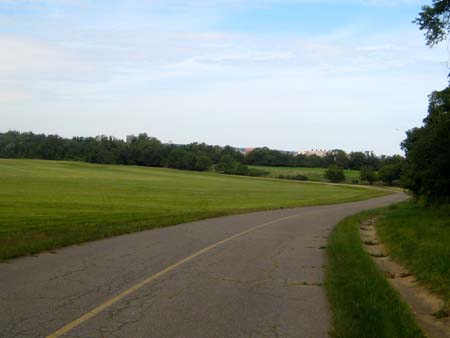
(Pretty and pastoral. The Park Service keeps it neatly mowed, and the deer looked at us with only mild alarm. No hunters here. We were feeling pretty good about ourselves at this moment.)
It may be the rain we have had this year, or it may be that the author of the directions has never been there, or the reconstruction of the Oxon Cove Bridge has changed everything, but where the semi-pavement ended the jungle began.
There was a faint trail leading off along the bank of the cove, and we took it. The ground was semi-dry, and the periodic surge in the river level had distributed the waste of man- plastic jugs, water bottles, anything that floats- in a thicket of trash, overgrown and new. The flooding had undermined trees, which had fallen across the faint game trail, and branches and dead sticks poked and thrust as we gingerly moved, step by step, and clambering over tree-trunks. Some downed trees were concealed by the new growth. My gaze was locked down at my feet- if I fell and ripped out the repaired muscles, I was going to be screwed for sure. I was glad Argo was with me- if I got fucked up, at least someone could go for help.
It was that quick, passing out of civilization and into the wild. Argo took the lead, and I was grateful for his presence since I could only gingerly place my feet, and panicked as vines and tendrils threatened to snag my sneakers and pitch me headfirst into spear-like branches.
It was only a half mile, perhaps, crunching along the discarded bottles and detritus along the bank, where we could follow it, and across a couple little fetid muddy streamlets.
Bugs? Sure. Bugs to spare. I looked down at one of the periodic shoes that were scattered along the trail, never a pair, always singletons, and not one I could see with the remains of a tibia or fibula protruding.
At one challenging clamber over a deadfall, I saw the skull of a large animal. Not human. Deer, I assume. I did not poke at it.

(Roof? Boat? Heavy lumber, whatever.)
It took more than an hour to cover the ground, approaching the roar of the interstate that surmounted the vertical stone retaining walls. There was evidence of previous structures- bricks scattered everywhere; a heavy wooden lattice- a roof? And even a section of footbridge, now stranded atop a jumble of driftwood.
We made it up a steep bank to the base of the wall of the bridge.
If there had ever been a path here, it was covered with random large stones to prevent erosion. There was no going forward to the aperture that would permit us to get under the freeway, and there the forward motion ceased.

(The castle wall of I-295. It would have taken climbing gear to scale the heights to the break-down lane on the Northbound side of the highway.)
Argo might have been able to do it, but not me, the gimp. I hurt and was starting to get alarmed at the prospects of a fall and another trip to the hospital. Thank God I was not alone. Argo scouted north and south to see if there was any way to get up to the roadbed where civilization whizzed by our 18th century jungle, but there was no way without climbing gear. The road and bridge were as impregnable as a castle keep.
The stone was only a thousand feet away, but it was safe this day, protected by the rampart of the interstate and cloak of the river.
The only answer was to turn back. Disappointed, aching, and with the same obstacle course to traverse.
“Next time we do it by boat,” said Argo. I nodded in agreement. And then we clambered back down the steep slope, across the murky driftwood field on the mud, and back into the jungle.

I won’t bore you with the return clamber Argo went on ahead to fetch the car and left me quite disoriented in the jungle on growth- I had been looking down so intently to avoid falling that I had only a sketchy idea about keeping the water to my left. Eventually I met him as he drove back down the road, and he deposited me at the Panzer.
“Thanks, Argo. Some of the stones have taken me five attempts to find and document. Two to go. I will find a charter boat for the next assault. Expensive, but that will almost close out the quest.” Argo looked at me dubiously.
I drove home, legs quivering. I managed to make it to the pool and worked out the leg spasms with steady, gentle movement. Then I opened the bar early.
It is a daunting prospect to realize that I had better complete this adventure while I can.
Copyright 2013 Vic Socotra
www.vicsocotra.com
Twitter: @jayare303
Getting Stoned

(Not my picture of SE 9. I hope to see it in person later this morning.)
This is a bit in the way of a place-holder, so bear with me. I will fill you in completely tomorrow, if we live. I hope that is the case.
So, ten years after I started this adventure, I am supposed to meet Argo and his Deutscher girl friend at the Oxon Hill park and venture into the foliage in search of the elusive SE9, the last (actually, second to last- I may have to knock them both out today since I rarely travel to the wilds of SE DC anymore) of the District Boundary Stones, first monuments of the new Republic.
I have had a pretty good run at seeing them all, and this morning there is
a trip to the beginning of the Republic.
I have written periodically of this quest to see all the remaining stones. The saga for me began in 2002, when I first learned of the extraordinary and mostly neglected monuments commissioned by Congress as one of the first public works of the new nation.
Congress passed the Federal Residence Act in 1790, 223 years ago. Maryland and Virginia ceded land to the new Government in accordance with the Act to form a diamond spanning the Potomac River, the lower anchor being Jones Point south of Alexandria, VA. The original District of Columbia was a square measuring 10 miles on each side, totaling 100 square miles.
Major Ellicott’s team placed boundary stones at intervals of one mile all along the edges of the Diamond. It was brutal work, hauling the heavy sandstone pillars to be placed precisely at every mile point along the borders of the new capital territory, with a ten foot clearing in the dense underbrush on either side.
It is a queer thing that so many of them are left. I guess it is because they represent the edge of things, not the middle. Two are in storage after misadventure; one in Alexandria is clearly a copy, though there is no reason for it. Two more are just missing, one replaced with a duplicate, and another trashed and replaced with a plaque. There are still more than thirty left in situ, some in good shape and some quite bedraggled.
But all of them have locations associated with them, if you care to look.
Argo has had an interest in my DC Stones adventure, and accompanied me on a chaperoned trip to the Boundary Stone located in the Dalecarlia Reservoir (NW 5), to which (legal) access is controlled by the Army Corps of Engineers. Actually, NW 4 is, too, though you can see it from outside the fence at the Montgomery County line.
Anyway, Argo saw those two with me, since I made an appointment with the Corps after a couple unsuccessful forays into the deep woods outside the Reservoir.
The handful of hard ones was slowly diminishing, since most are fairly near roads or accessible public areas (the ones in private hands in what used to be the District component of Virginia require some modest private trespass).
Left on the menu were SE 8, in the wilds of Anacostia and located in the DC Impound Lot, not far from the unmarked graves of the German U-Boat saboteurs executed in the DC Jail in 1942. That required several trips to identify, and it was useful to have a posse with me, since frankly the place is scarier than shit. Potters Field, Ward 8, deer, drug deals and all that sort of stuff.
Today, DC 9 is the target. It is on the shore of the Potomac, near what once was the ferry terminus from Alexandria, and now is scrub on the west side of I-270. I suppose you could just pull off the highway and clamber down, but I think we are going to drive to Oxon Hill Farm and park in the NPS lot and hike a mile or so in.
That will leave NW 8 as the last one, though actual touching of all of them once was the goal. That one is located on a trail off Eastern and Kenilworth Ave, and is another I would prefer to visit in a group, and to take the Police Cruiser to visit, rather than the Mercedes.
Anyway, if I nail DC 9 morning that will at least represent an attempt to see them all, and the last one before the jump back across the Wilson Bridge to the first one placed by free African American Benjamin Banneker at Jones Point, the location of which was selected by George Washington.
Then a swim, I guess, or just push off from there for the farm and try to decompress. There’s been so much shit going on for so long that I am quite exhausted by the whole thing.
Still, here is to Ellicott and Banneker, and times that seemed a lot less complex.
Copyright 2013 Vic Socotra
www.vicsocotra.com
Twitter: @jayare303
Trolls

(I don’t know where these particular trolls work. Could be one of several Agencies, or they could, of course, be free-lance, given the state of the economy.)
OK- twice this week. I generated another story that I cannot do anything with, exactly like yesterday. I won’t trouble you with old news- am going to have to take a hard look at what I am doing. Maybe there is something in the water at the new apartment, or perhaps it is the effect of the increased time I am spending in the pool.
It has been wonderful, having a little more time in the day. The challenge is to find something positive, besides therapeutic exercise in which to fill it up.
I am frustrated with news, as you well know. I am digging at all sorts of threads, some of which make sense, and others that do not. Maybe the news about the amazing NSA surveillance program has me a little uneasy. I know it does many people- but in reading some of the accounts I find myself with the luxury of time to read the comments people post about articles on a variety of topics.
I am not talking about the New York Times: there at the Gray Lady, you get exactly what you would expect. A New York Progressive lens that reflects accurately the basis- and bias- of the paying audience.
But on some other sites, notably the alternatives to what passes for the Mainstream Media, there are responses that are oddly similar. It struck me this morning that there are either a large group of people with strikingly singular and seemingly scripted doctrinaire views, or there is something else going on.
Could it be that someone is being paid to monitor opinions that differ from the government’s accepted line? There is a term for amateur harassment in the blogosphere- they call them “Trolls.” Is it possible that people are paid to do this? Sounds crazy, but if you had told me that the IRS would be used to do exactly that, I would have said I was trapped in a Nixonian nightmare. And yet, that is exactly what happened.
I confess that the continuing cascade of events is getting my knickers in a bit of a knot.
Could anyone explain to me exactly why we are supporting Islamic radicals in Syria, to the extent that we have armed them against the sitting government with absolutely no prospect of an outcome positive to the United States?
That we effectively have thrown our support behind the Muslim Brotherhood in Egypt, while China and Russia have lined up with the secular opposition?
If you had suggested to me that we would not only be on the side of the table with the people who revere the 9/11 terrorists, only a decade along, I would have looked at you in disbelief.
But that is what we are expected to do these days, I guess. That or go on vacation, along with common sense.
Copyright 2013 Vic Socotra
www.vicsocotra.com
Twitter: @jayare303
Clams Cassini
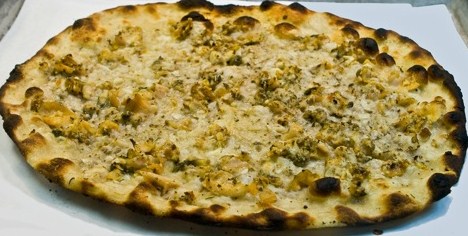
So, I had this story all good to go this morning, and then I looked at it and actually read it, and the whole thing made me ill.
It was about Tuffey Geffling, and if you know who he is, you already know more than we ever needed to know, and the predictable has happened, and the story is disturbing on several different levels, all about the level of discourse in this fine nation and I am just sick to death of it.
Anyway, I was more interested in talking about clams Cassini, which Tracy O’Gady, executive chef and co-owner of Willow has whipped up as a specialty topping for her legendary flatbreads just in time for Restaurant Week next week.
It is sort of fun to be along for the vicarious ride as Chef changes her menu, tinkering with it, moving from culinary triumph to triumph. I have been staying away from carbs, but was saving up to try the clams Cassini flat-bread last night.
I sort of egged Jerry-the-Barrister into buying one- I offered to have a couple slices of the small one, but he was expansive and ordered the full. He is jetting off to Italy late today, so I took advantage of his hospitality.
That was before some unidentified part of his heritage tomato salad went down the wrong pipe and I thought we were going to lose him, but that is an entirely other story, like the one Old Jim was spinning about the proper Richmond gentleman in the seersucker suit who came to dissuade him from messing around with his wife, who was in the travel game and was interested in turning a convention dalliance into something longer term.
That happened in the One Step Down, a bar that that sat for decades at 2517 Pennsylvania Ave. It was a quirky place, with equally quirky management but was a low-key D.C. jazz hub that welcomed those of all ages and backgrounds.
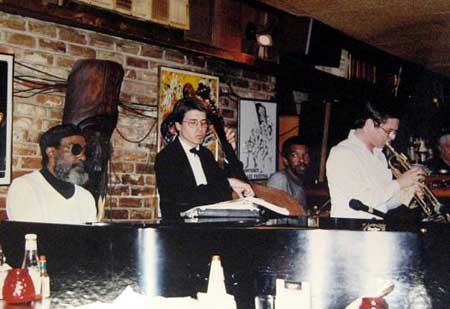
Jim used to live in an apartment upstairs, and at the time of the story, a pal who was a burly African American was crashing with him, just until times got a little better.
It was a good story, having all the proper elements of a bar time yarn, in that it happened in another bar, but was not a country story, since there were no trains, or pickup trucks or Momma’s failed expectations in it.
It was an urban tale, featuring some hard cases, all of whom had pistols in their back pockets, and drinking in the afternoon, and the incredulous look on the Richmond fellow’s face when he announced he was looking for Jim. Knowing that proper Southern Gentlemen do not come calling on matters of Honor without a pistol in their back pockets, and Jim decided that discretion was the better part of valor.
After the Owner claimed that he hadn’t seen Jim all day, and the man in the seersucker suit became more agitated, Jim decided to do the right thing. He pointed at his very large temporary room-mate and announced that he was Jim.
The Richmond fellow was nonplussed, and his eyes got large in the dimness of the bar. He sputtered that Jim should no longer mess with his wife and skedaddled out of the bar as fast as he could go.
Jim’s pal looked at him and put a massive hand on his shoulder.
“Don’t you ever do that again,” he said. “He could have had a gun.”
“Well, so do we.”
“Just don’t do it again.”
The One Step Down is regrettably closed now, turned into a place for high-end condos or something like what is happening all over the District as the Yuppies take over and gentrify the buildings. A Subway franchise occupies the venerated spot now.
The Lovely Bea and John shared some of the clams Cassini, but that wasn’t enough. After we were fairly sure that Jerry was not going to die, they decided to split the award-winning burger and one of the braised short-rib sliders.
This is what the award winning burger looks like:

They enjoyed it. Maybe we will see you at Restaurant week?
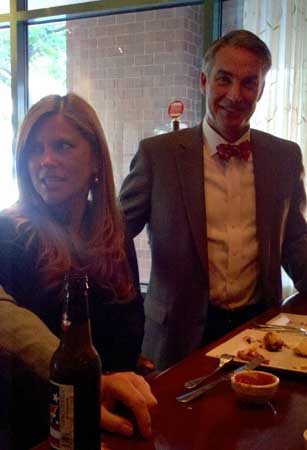
Copyright 2013 Vic Socotra
www.vicsocotra.com
Twitter: @jayare303
Traffic and Weather on the Eights
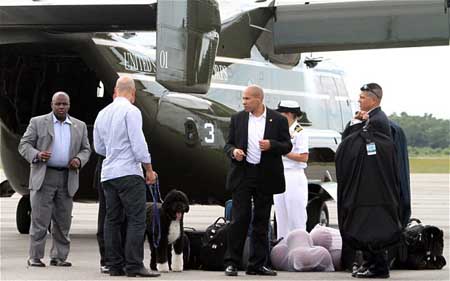
(Presidential Dog Bo, accompanied by his walker, four Secret Services Agents, a Navy Lieutenant, the Presidential basketballs and assorted luggage, arrive at Martha’s Vineyard via the new MV-22 Osprey flown by US Marine Presidential Support Squadron HMX-1).
I got all the answers this morning.
Well, not ALL the answers, but a couple good ones, but of course the answers just cause more questions. I wish I had a good recipe for you, but it is just that sort of morning.
I was listening to WTOP this morning- the mindless traffic-and-weather-on-the-eights outlet- rather than KRCC, the public radio outlet in Colorado Springs, which plugs me into the BBC in their early morning hours. With everyone, including the first family on vacation, I thought it might be fun to listen to the local traffic, since we have bands of rain coming through, and it makes me feel good that I am already well inside the Beltway and able to do anything I need to do without traffic imposing on my movements.
Anyway, I-66 was the topic of interest this morning, early. An personal injury accident was referenced that had closed the right two lanes off the eastbound concrete, just at the place where the road narrows from four lanes to three, except for rush hour, when the shoulder is permitted to be used for through travel.
Apparently a man was on foot on the Interstate, and was struck and killed just before five AM. That is the time I used to be on the road, heading in to the Pentagon to try to secure a decent parking space. I don’t know more about the accident, except how surreal it must have been to be ambling along in the darkness and then transition to eternity on the bumper of a commuter doing seventy miles and hour.
Apparently whoever hit him did not stop to render aid.
I wondered who it was, and how they came to be afoot in that place. Was it a drunk, coming back from somewhere and not realizing there would be high-speed traffic on what appears to be the shoulder of the road? A motorist walking away from a disabled vehicle?
It is amazing how one individual problem can cause the alleged capital of the Free World tie itself completely in knots.
As I said, I do not know the answers, only the consequences, which is that the vast road is snarled for twenty miles back out past Manassas, and that could be me, attempting to get to Blue Arlington from Red Culpeper. Life is a very strange thing, isn’t it, and disturbingly finite.
Oh, I mentioned that aside from that mystery, some of the other great questions have been answered. I will save you the effort of having to listen to weather-and-traffic on the eights to divine the news:
Yes, Bo the Presidential Dog got a lift to Martha’s Vineyard on a brand new V-22 Osprey tilt-rotor aircraft. It was not a wasted trip, and certainly not just for the dog. The Dog-walker was along, plus four secret service agents, a Navy Lieutenant, and the Presidential basketballs. I could only count eight, but it has been a while since I did detailed imagery mensuration.
I am not going to be one of those who clucks about the President taking a $100 million trip to Africa for no discernable national security purpose. I am sure there were pressing issues there, and the first family needs a break from travel by traveling. I support Bo’s traveling independently, too.
Imagine if everyone was on the same plane and something happened?
Which is of concern, since another bit of information is floating around this morning. I was not present that night in Benghazi, when the reaction to that amateur video caused a heavily-armed jihadi group…oh, wait, I am getting this all mixed up with the initial response to the murder of a US Ambassador, and then the revelations that there were 40-odd CIA officers doing something in the annex to the Consulate.
It was all a long time ago, as Mr. Carney reminds us all the time.
Still, it appears to be one of the things that has presumptive Presidential candidates and their pals a little nervous, and conducting weekly polygraphs on people who actually know what was going on.
It is all sort of queer. My suspicion from the git-go was that there was an active operation to get deposed-dictator Muammar Qaddafy’s arsenal out of Libya before it fell into the hands of the crazies.
There is one likely destination where they could have been useful, wink wink, and that of course is the other crazy bunch of rebels, the Syrian Opposition. They are the only ones who could possibly make Bashir al Assad look reasonable. Given the Administration’s policy in favor of them, I have no idea why that would be such a deep dark secret, but the word floating around this morning is that the guys who took the consulate, murdered four Americans, and are still at large also managed to get away with a few hundred man-portable surface-to-air missiles.
That would be sort of bad, you know? But on the other hand, if that were true, would the Secret Service let the dog fly on his own?
Sometimes the more you know, the more confused you get.

Copyright 2013 Vic Socotra
www.vicsocotra.com
Twitter: @jayare303
Shelf Life
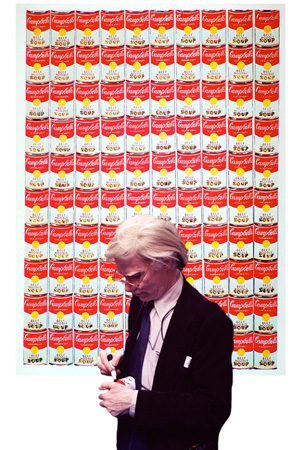
(Pop artist Andy Warhol signs a can of Campell’s tomoato soup. The owner should act now- the shelf life of the can is finite, much like pop art itself. Photo New York Times.)
I will not trouble you tales of mayonnaise this morning. The weather is too delightful to worry about the ingredients in a creamy, oil-and-egg-based condiment. But I have been thinking about spices and food, since some of the contents of the pantry from the old unit are still in the garage at the farm, and they are one of the things I will have to deal with now that there is the prospect of having the time to actually get organized.
I think it is prudent to have some canned goods and dried foods put aside in case of natural or man-made disaster- it is only prudent, right? I agree with the Latter Day Saints on that score. But there are some things- that thick can of baby oysters, for example- that I think date to 2002.

(Polar explorer Earnest Shackleton’s historic 1908 hut at Cape Royd.)
In Earnest Shackleton’s historic 1908 hut at Cape Royds on Ross Island in Antarctica, some of the original tinned food is still present from the long-ago expedition, and possibly still edible. I shudder a bit at the idea, but there is a lot to shudder about if you think of food. I will get to the connection in a minute.
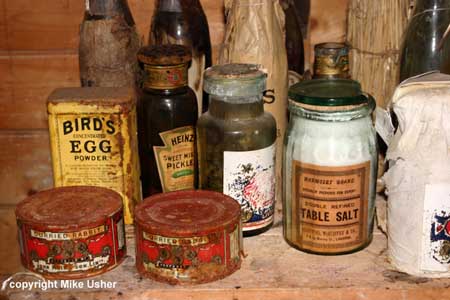
(Shackleton’s pantry today. Photo courtesy Mike Usher).
I sort of wandered off from the rich creamy taste of mayo and into the world of Big Corn yesterday, and dragged some of you with enough sense of whimsy along with me. I got a note from the Argonaut about a life-transforming book regarding corn- and I only managed to scrape the surface of that tasty vegetable- the husk of it, if you will.
So not only does Big Corn make us fat, drive up food prices in the Third World, provide a wasteful diversion of energy while simultaneously corroding our automobiles, it has infiltrated virtually everything we eat all up and down the food chain. It is frankly more than a little terrifying. Try a read of author Michael Pollen in his book “The Omnivore’s Dilemma.”

I bought it on Amazon in the Kindle version- though perhaps I should start examining my relationship with the merchandizing giant in light of founder Jeff Bezos’ recent purchase of the Washington Post. That is a food of thought chain with which I prefer not to be associated. But I digress.
In his book, Pollan identifies the industrial mechanism that created the modern food chain, and what is available for us to purchase and ingest at the Harris Teeter, or Kroger, or whatever industrial mechanism that brings sustenance to our tables.
Pollan thinks that the groups of food- industrial, organic or alternative food, are largely based on corn. The stuff from the meat case? Beef, chicken or pork: all those animals were fed on corn. Corn is the root of all of it: the evil High Fructose Syrup that sweetens everything, the organic material from the plant that is stripped and recombined into the packaging and materials to construct the store itself.
It is mind-blowing to consider how dependent we are on corn.
I am partly out of that chain, thanks to the earnest efforts of the Russians next door. They did not put in corn this year, and the bounty of their truck patch is such that I leave the place each week with so many cucumbers, tomatoes, melons and peppers that I myself have to give them away before they go bad.
They are nutritious and fresh beyond belief. Last night, after a refreshing swim and an even more refreshing vodka, I sautéed them all with some store-bought mushrooms and onions and threw a last item in the microwave.
An ear of corn. It was relatively fresh, and thoroughly delicious. But I confess, I looked at the cob this morning where it sat on the dish that I did not clean before bed with suspicion.
Read the book. You are never going to look at dinner the same way you did before.
I think, on the whole, that mooching off the Russians when the harvest comes in is an acceptable option for now. But what happens if the food chain is interrupted? I am not much of a survivalist, but like I say, having a stock of edible food seems only rational these days. Having had a can of pineapples explode in my cupboard a couple years ago (I was reminded when I had to clean the top shelf of the pantry last week before selling the place) just how safe all that stuff was.
You know, the “best before” date stamped on the can? I saw some that were issued before my last passport expired. I checked up on it.
Beyond the Antarctic expeditions, there is domestic evidence of how long the cans can last.
The steamboat Bertrand, under the command of Captain James Yore, was carrying cargo up the Missouri River to Virginia City, Montana Territory in 1865 when it went down after hitting a submerged log in the Desoto Bend. The wreck stayed on the bottom for over a hundred years before it was salvaged, and its cargo included everything a Civil War-era frontier community desired- including canned goods.
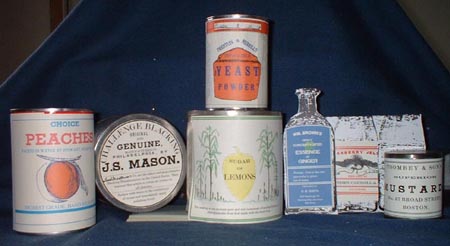
(Cargo or the steamship Bertrand. Photo NFPA.)
Among the food items retrieved in 1968 were brandied peaches, oysters, plum tomatoes, honey, and mixed vegetables. In 1974, chemists at the National Food Processors Association (NFPA)- a known part of the industrial food chain- analyzed the products for bacterial contamination and nutrient value.
The scientists sniffed a bit, and allowed as how while the food had lost its fresh smell and appearance, they detected no microbial growth. They pronounced the foods were as safe to eat as they had been when canned more than 100 years earlier. So, although tomatoes produce sufficient acids to dissolve the cans, compromise the seal and explode (Andy Warhol’s classic pop art is definitely a finite commodity) I am not going to worry about what is in the garage at the farm.
Not yet, anyway, but I imagine if I have to resort to that, I am going to have more problems to deal with than just the food chain- since by that time, you and I may very well be part of it.
Copyright 2013 Vic Socotra
www.vicsocotra.com
Twitter: @jayare303
Big Corn

Sometimes these stories happen all by themselves, and I can honestly say I have little to do with it. This morning was one of those little epiphanies. I slept fitfully, and the night was deep and very quiet at the farm, and least until the rains swept and the impact of the drops resonated through the tin roof, on and off.
I rose without much thought about what was to come, and it arrived completely unexpected. But let me not get ahead of myself, as usual. I will predicate my remarks with the observation that not all things big are necessarily bad.
Not necessarily. Still, I have some reservations about that. Think about the Institutions that have “big” in their names: Big Government we hear about all the time. But also, Big Banks, Big Oil, Big Tobacco, Big Pharm and Big Science follow pretty closely. They have given us a host of issues, mostly based on the self-interest of the entities concerned, public or private.
Climate Change- formerly Global Warming- is the concoction of Big Science, largely funded by the government. They darkly accuse anyone who disagrees with them as being dupes of Big Oil, and as evil as Big Tobacco. If what we suspect is true, it is possibly one of the larger scientific errors since Galileo told the Pope he was wrong about what heavenly body rotated about what. The view that Man, and our use of fossil fuels is the basis for a whole topology of issues.
You can see a contrarian view to the revealed wisdom at this link, with our new reality of nearly 400PPM of CO2 in the air. As it turns out, It isn’t so bad after all:
But I am not going to beat that drum this morning. So much of what we do is based on erroneous assumptions. Like the bio-fuels thing. An objective look indicates what we are doing is nuts, at least until you consider the political reality of it.

Which is a long way around the rose bush to get back to mayonnaise, a topic which I hardly expected to generate a series of stories.
A former comrade wrote with this comment: “Vic – you might try Harris Teeter’s Supermarket– I believe I’ve gotten Duke’s there in the past as they are expanding into “northern” markets. It’s a staple down here, along the James River area. We like it, but are still Hellman’s (Best Foods Mayonnaise – west of the Rockies) fans, too.”
I was strongly motivated about the creamy sauce, and wrote back immediately:
“There is quite a tale to the Hellmann’s- Best Foods saga, including the famous decision to keep two names for a single brand. I would dig into it- the mayo itself, with 50% of the domestic market share, is a decent product.”
Shoot, I used to be a Hellmann’s guy myself, and still consider it an excellent base for home-made Thousand Island dressing, a guilty pleasure with a decent wedge salad that was first revealed to me in the actual Thousand Islands by an old college buddy named JT:

Ingredients:
Servings: 5
1/2 cup mayonnaise
2 tablespoons ketchup
1 tablespoon white vinegar
2 teaspoons sugar
2 teaspoons sweet pickle relish
1 teaspoon white onion, finely minced
1/8 teaspoon salt
1 dash black pepper
Directions:
Combine all of the ingredients in a small bowl. Stir well.
Place dressing in a covered container and refrigerate for several hours, stirring occasionally, so that the sugar dissolves and the flavors blend.
Hellmann’s is fine, but there is a backstory to the brand that makes me prefer Duke’s Rich and Creamy. No High Fructose Corn Syrup (HFCS).
Remember how that got started? It was in the tenure of Dick Nixon’s Agriculture Secretary, the legendary and controversial Earl Butz. In the scandal over his insensitive remarks that prompted his departure, we forget Earl had been directed to come up with a solution to hunger in the US by Mr. Nixon. One of the answers he came up with was HFCS, the sweet infectious ingredient that yielded (by some accounts) the American obesity epidemic.
It is one of those unintended consequence things. It was cheap, an abundant source of calories (albeit empty ones), and could be used to sweeten just about everything. Corn producers loved it. Corporations saw dollar signs.
That is how it comes around to Mr. Hellmann’s mayo, taken from a German family recipe provided by his wife, and first schmeered on sandwiches in 1905. The basic product was good enough to help him get out of the Deli business on Columbus Ave in NYC and concentrate on the schmeer business full time. What happened after that is interesting.
The Hellmann Brand was acquired by the Best Foods Folks, during a series of consolidations in the global food chain.
Big Corn is lurking back there in a way that I find sinister (though as an intelligence professional yourself, you know the inclination to poke for the worst case scenario). We know that no candidate (while Iowa votes first in the primaries, anyway) can oppose the insane policy of adding corn products to gasoline while millions go hungry world-wide.
We know the increased percentage of “sustainable” corn-based additives mandated by the EPA that will dump the accursed E85 blend (15% ethanol, currently only ten percent) into our tanks, and which will destroy our cars (save those specifically designed to accommodate the corrosive mixture, and that does not include small engines for lawn mowers, boats and all the rest).
It does not make sense, but it is the law. You might want to drop your congressional member a note about it, not that the EPA will pay any attention.
Anyway, Hellmann’s, a perfectly fine product, was part of the agribusiness consolidation that swept over the back-room of American food. The corporate Who Shot Mary goes like this:
Ingredion Incorporated (formerly Corn Products International, Inc) is the sinister entity that had a perfectly honest name, but needed some cover from the emerging bad press over HFCS.
Headquartered in Illinois, Ingredion “processes corn, tapioca, wheat, potatoes, and other raw materials into ingredients for the food, beverage, brewing, and pharmaceutical industries as well as numerous industrial sectors.”
It has more than 10,000 employees around the world, and customers in more than 60 markets in over 40 countries. In 2011, net sales were $6.2 billion. Did I mention that Westchester, IL, the corporate HQ is in Cook County, sharing the jurisdiction with Chicago?
I am sure it is just a coincidence.
As Corn Products Refining Co. and later on as “CPC”, the company supplied the raw materials for Argo Cornstarch and Mazola corn oil from 1919 (two years after Mrs. Duke first produced her version of the sugar-free creamy sauce) through 1987.
In the meantime, CPC formed a partnership with Texaco in 1981 to produce bioethanol, and eventually spun off that company as an entity called Aventine Renewable Energy. How much did they get from the TARP? I will have to check.
From 1958 to 1997, Bestfoods was part of the conglomerate, with the flagship mayo brand along with Maizena, Knorr, and- God help us- Skippy Peanut Butter.
In 1997, the company was split into a packaged-food company, Bestfoods, and a starch company, Corn Products International. Corn Products International (CPI) is a Fortune 1000 Company. the CPC factories were sold to the French sugar manufacturer Béghin-Say and renamed Cerestar, which was, in turn, acquired by Cargil in 2002.
Cargill is now the largest privately held corporation in the United States (by revenue).

I imply nothing by the corporate history. I said at the top of this that Big does not mean “bad.” That would be naive. But big does mean there are resources available those that are that are not to the rest of us. That translates into the ability to influence candidates, and hence, national policy.
I enjoy a slather of Duke’s in my chicken or tuna salad now, and intend to check out the tip from my pal about it being in stock at the Harris Teeter that opened a few years ago on Glebe Road, adjacent to the Buckingham neighborhood where Big Pink looms, since there is no HFCS in the recipe.
I noted with alarm though about the news a couple months back. Harris-Teeter was recently cleared by the Securities and Exchange commission to be sold for cash to the Kroger corporation, which in turn operates 2,400 grocery stores across the country.
That could be a lot of Duke’s (or Hellmann’s) on a ton of shelves.
Bring out your best, right?
Funny, we don’t talk nearly enough about Big Food. It is interesting what we put on our sandwiches, isn’t it?
Copyright 2013 Vic Socotra
Duke’s
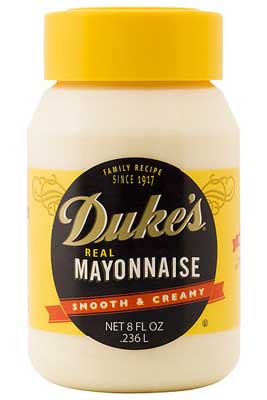
I had a good day Friday, puttering at this and that, and “worked from home” until the decision-point came about leaving the new residence and the hypnotically attractive diversion of the pool. I had already logged an hour of treading water, and though the ravaged of the tumult of travel and moving had me a bit ragged, I decided to venture out and go to Willow for a break.
Tinkerbell was tending the bar along with Big Jim, filling in for Tex, who was on a cruise or something. August is the month of vacations, after all. We were discussing the President’s latest vacation, and the general noise level of a recently inebriated party at the tall stools over by the wall when my favorite Flag Officer strolled in. I had not seen him since I worked at the phone company, and he was running errands in town while the family was getting together with his daughter.
I made the introductions with enthusiasm, including Barrister Jerry, who was hitting on a lovely young woman about a third his age. “We met when we were all camped out at the Navy Lodge in Coronado, waiting for quarters to open up, and I think we were in a conspiracy to conceal the existence of the dog, who technically was not entitled to government billeting.”
Bill was a surface line guy, and one of the real gentlemen I encountered in almost three decades in the Navy. I last saw him as a PhibGru Commander, embarked in the marvelous and then-new USS Essex, and it was a pleasure to be underway with him. He is an occasional reader of my nonsense, and consequently decided to pop in to Willow and see the place in person. I was glad I made the effort to get our, or I would have missed him.

(USS Essex underway. Bill is second from left on the bridge. Photo USN)
He could only stay for a drink, and then was on to the rest of his errands, but it was great to see him and catch up on his transition from active duty to retirement.
“Seemed like a nice guy,” said Jim, glowering at a Yuppie elbow from the raucous crowd that was pressing into his back from the overflowing cocktail nook.
“He is among a the number of Great Americans I was privileged to know in the service,” I said, taking a sip from the tulip glass in front of me while one of the yuppies inserted himself between us to get Tink’s attention.
“Your story this morning was about nothing,” he said.
“Yeah,” I acknowledged with a guilty smerk. “I had to do a Seinfeld Socotra. I am taking a break from Red Baiting and polemics on Iran and Syria. And the phony scandals. The whole thing makes me sick. Tomorrow I think I am going to write about mayonnaise.”
Jim scowled. “I won’t read it,” he said firmly, and ladled a spoonful of Frank’s hot sauce over the halibut slider that serves as his evening repast at the Amen Corner.
You see, Tracey O’Grady normally presents the fish sliders with a side of tartar sauce, which I adore. It has a tangy pickle taste amplified by a rich white sauce. I like it so much I don’t order it- the fish and chips was a staple of mine for a couple years, but I have tried to turn the food thing around.
I strive to have a big breakfast, moderate lunch, and small dinner. Better If I can skip it altogether. All my life I had done it the other way around, and this seems to work- that and staying away from the carbs I love. Having a halibut slider with a side of Tracey’s tartar sauce is a moderate response to the inversion of calories, by my lights, anyway. But Jim just doesn’t like mayonnaise.
He is always quite specific about getting hot sauce on the side. There is a reason for that. Recently he was affronted when the kitchen staff produced a little container of Sriracho, the vaguely Asian hot sauce with the rooster on the label.

(Willow Executive Chef and co-owner Tracey O’Grady. Photo Socotra.)
I asked Tracey whether she made her own- it seemed like something she would do, as a culinary perfectionist, and she said “Yes, for some applications. But not for things like the Tartar sauce.”
“What sort of commercial mayo would you use?” I asked. I had recently moved away from Hellmann’s (“Bring out the Hellmann’s, and bring out your best!”) toward a new brand that looked interesting, Blue Plate. I found out, purely by accident, that an ominously-named conglomerate called “Corn Products International, Inc.” had acquired the brand name somewhere along the way to a 50% market share.
High Fructose Corn Syrup may be the single greatest threat to America’s security, far higher than global whatever or Iran, so naturally I started looking around for alternatives without a hint of it in the condiment.
Now, I have to tell you I was never a mayo purist. Big Mama was a Miracle Whip sort of cook, which is to say, whatever was convenient was good. Not that she was a bad cook, quite the contrary, but rather a expeditious one. She had other things to do besides stand in front of the range.
There are still evocative tastes- with peanut butter, for example, on a nice crust of bread, that is the essence of a comfort food of youth, before I discovered that just about everything is rigged, and for a lot of folks, there is no objective truth, just the situational kind. It is not that way with the mayonnaise.
I like to think my palate evolved even as my view of the world shifted to one of general suspicion. Miracle Whip to Hellmann’s to Blue Plate (“An excellent source of Omega 3!”) to Tracey’s magnificent tartar sauce.
Which is why I asked what she used, when she wasn’t whipping up her own.
“Duke’s,” she said firmly. “It is the best commercial mayonnaise on the market. They don’t use any added sugar in their recipe, which makes it a better platform for specialty sauces like our Tartar Sauce. It is sort of a regional thing, but I like it because it has a more traditional, less sweet taste than other commercial brands.
“Thanks, Tracey,” I said. “I will look into it.”
I did not recognize the brand from anything I had seen at the Commissary, so I did the research at home.
Mayonnaise is as old as the hills. The original, possibly from the Mediterranean, was a simple mixture of whisked olive oil and eggs. Sometimes mustard is included. There are a variety of origins cited in Wikipedia, which does not include my personal favorite.
Back in the days when Johnny Carson was the king of late-night TV, his amiable sidekick Ed McMahon advanced the proposition that his ancestors had created the creamy sauce after being expelled from Ulster by Queen Elizabeth in the great Plantation of Ireland.
Resettling in France, Ed claimed, his family created a creamy sauce was called “McMahonnaise,” which devolved to the term we use today.
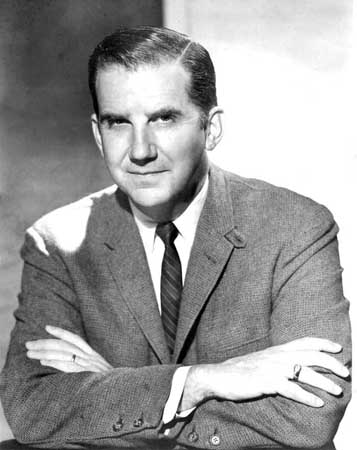
I think that is probably nonsense, but I am in no position to disagree with the icons of the last century, any more than I could get Jay Carney to say the same lie twice the same way.
Our versions of the commercial sauce date from the time when Johnny and Ed were just gleams in the eyes of their old men. Hellmann’s dates to 1905, and a deli on Columbus Avenue in the Big Apple. Duke’s was created by Mrs. Eugenia Duke of Greenville, South Carolina, in 1917. As such, it is generally a regional brand, though discerning chefs like Tracey spread the word.
I was intrigued enough to search out Duke’s on the web, (http://www.dukesmayo.com/) and ordered one of their 32-oz. jars, which was delivered to Big Pink in a trice. Helman’s and Kraft have recently cut the size of their jars to 30 oz and boosted the price, so I grateful Duke’s has held the line. Very impressive service, and when I opened the jar, I realized Tracey was right.
But last night the Friday fever was a little overwhelming for the semi-retired crowd. Old Jim looked on dyspeptically at the crowd of yuppies that was actually touching him.
“I am going to have one more beer and get the hell out of here,” He declared, “Yuppie scum.” I thought that was a remarkably good idea.
“Hey, Tink!” I yelled down the bar, “Reinforcements, and the check!”
“The what?” asked Barrister Jerry, turning his attention back from the gazpacho, crispy spring rolls and the dark haired beauty to his right. “You are slurring your words.”
“What did you think I said?” I sputtered indignantly. “In that case, I might have two.”
Dukes Cole Slaw (by Vic)

Ingredients:
One bag thinly sliced cabbage (or slice it yourself)
One cup Duke’s Real Mayonnaise
One cup Cider vinegar
¼ cup cane sugar
Sea Salt and fresh ground pepper
Poppyseeds for emphasisis*
Directions:
Dump all the stuff in a bowl. Stir vigorously until well mixed or you get bored. Add more mayo if it looks too runny, more vinegar if it is too sweet or too bland, and more sugar if your lips pucker. Cover and let sit overnight. Stays good for just about as long as you need it to. Cabbage is a cruciferous vegetable, and it is just darn good for you.
* Not recommended for readers subject to random urinalysis.
Copyright 2013 Vic Socotra
www.vicsocotra.com
Twitter @jayare303
The Union Market

(The Grayhound folks took over the old Union Market that failed against the rise of the corner supermarket. Funny, I used to work in the Bus Station on New York Avenue in DC, and now I have slept in one. Image Drury Inns and Suites.)
Sorry, gentle readers, slept hard and late last night as the consequences of the last week finally caught up with me.
In my defense, a couple other things happened this morning as I shambled into the day that caused me to be…well staring blankly at the computer screen.
I had wanted to talk to you about the cool hotel at which I stayed in St. Louis- the Drury Suites at the convention center.
It was a really neat structure, and very strange. Obviously re-purposed from something else, heroic in nature, though as it turned out, it was nothing of the sort.
The Drury Suites was a public building constructed on the site of the old Union Market, a vast public sales venue that served the entire city. The original structure dated to 1866, and Mark Twain would have picked up some apples or a potato for the dinner table there. That structure was in turn ripped down in the Roaring Twenties, when Jimmy and Andy’s Neighborhood Tavern was still a legal business before going underground as a speakeasy.
The current one, the base of the Drury Suites, was erected by the city in 1`925 at the cost of $1.3 million, a princely sum at the time. The architect was a fellow named Edward e. Christopher. His brick is severe, ornamentation grave, and the great grills of bronze and really impressive.
Public markets were once a vital part of St. Louis life. People thronged to them to purchase food because they provided a far greater variety of foods, simple and gourmet, than the smaller corner grocery of that day.
As a meeting place for shoppers it had its social aspects. The structure was designed by Edward E. Christopher. The market officially opened on November 5, 1925. When the doors opened at 7 a.m., crowds of people visited the building interested in seeing the second largest structure of its kind in the United States.
The new Union Market possessed the newest innovations and appointments in the handling of food products. In the interior, there were terrazzo floors, white enamel brickwork for cleanliness, plate glass, and furnishings of marble and polished metal. Food was serviced by a central refrigeration plant which furnished the correct temperature uniformly in every stand.
Unfortunately, the handsome new Union Market was never a rousing success. Interest in public markets began to wane and the corner groceries grew larger and more important. People were going to the well-stocked private groceries and meat markets that were springing up everywhere. The grand new place was a white elephant in the changing face of America, and the Dpression killed it off.
Over the years, Union Market supplemented its income by providing parking garage space and by renting part of the structure for a bus terminal, as in the post card at the top of this tale.
I have stayed in a lot of hotels down through the years, and there are many chains I avoid when I have a chance. Charles Drury owns this one, and he has done a remarkable job of re-purposing old and classic structures across the country. He saw the Bus Station in 1976, and despite the tanking of the downtown, he conceived the idea of opening a hotel atop Union Market became a reality in 1990. Mr. Drury’s intention was to renovate and expand the property into a 178-room hotel that would become a major part of the St. Louis Convention Center market.

(Lobby of the Drury Inn & Suites, Convention Center, St. Louis. It has the same sort of elegance as the Willard in DC.)
Through careful renovation of the first floor, many of the building’s original features are retained throughout the hotel lobby and mezzanine meeting level. An additional two stories were built atop the existing four, which provide the 178 guest rooms. The entire project was based upon the premise of carefully blending the past to the present, a thoughoughly commendable goal. It is one reason why I think St. Louis may live- stay out of East St. Louis, of course- and Detroit may not.
Anyway, sorry about the commercial this morning, but I was impressed enough with the free food and friendly staff and magnificent building that I wanted to tell you about it.
It is much preferable to the other story I was puzzling over. I saw thatThe Times of Israel is claiming that a fellow named Amos Yadlin, chief of the IDF’s Intelligence Directorate from 2006 to 2010, is suggesting that that people in the Obama Administration may be softening their stance on an Israeli strike against Iran:
“In 2012 the [Americans’] red light was as red as it can get, the brightest red,” Yadlin is supposed to have said in an interview with Army Radio Wednesday morning. “But the music I’m hearing lately from Washington says, ‘If this is truly an overriding Israeli security interest, and you think you want to strike,’ then the light hasn’t changed to green, I think, but it’s definitely yellow.”
That could be a very interesting development, and I am thinking it would be better to be as far away from here as possible.
Maybe back to St. Louis, who knows. If so, I highly recommend the Drury Suites. Great Hotel, if you have to be out of DC for a while waiting for things to cool down.
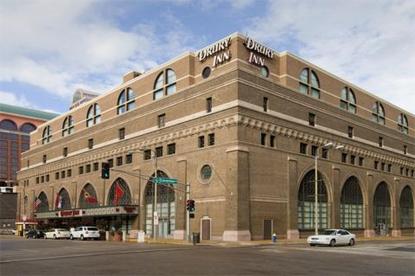
Copyright 2013 Vic Socotra
www.vicsocotra.com <http://www.vicsocotra.com>
Twitter: @jayare303
